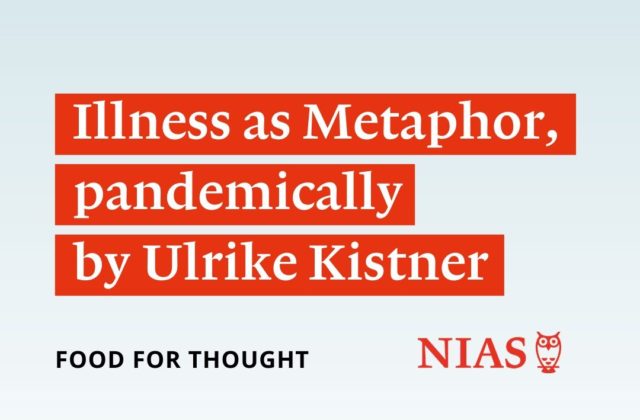‘The corona crisis’, as it is referred to short-hand, spawns a proliferation of images and metaphors surrounding the corona virus. It recalls the title of an influential text by Susan Sontag, Illness as Metaphor, published in 1978. Sparked by the experience of treatment for cancer, Sontag’s philosophical reflection sets out to challenge the mythologising, moralising and stigmatising effects of common metaphors of illness. In a context in which illness itself no longer holds a form of truth with respect to the subject, she contends that ‘… the most truthful way of regarding illness and the healthiest way of being ill, is one most purified of, most resistant to, metaphoric thinking’ (p. 3).
Sontag’s analysis of Illness as Metaphor focuses on metaphors of cancer (commonly considered to afflict persons lacking in passion and sensuality, and prone to inhibition, repression, and depression) and tuberculosis (historically considered as disease afflicting creative minds, also as indicating lack of passion, or as sign of punishment). Ten years later, in a sequel, Sontag turned her attention to AIDS and its Metaphors (1988).
From a short experience of public health communications and media reports on the current pandemic, we could add some more recently trumped up metaphors for critical scrutiny – for instance, Donald Trump’s designation (now retracted) of the Coronavirus SARS-CoV-2 as ‘Chinese virus’, Emmanuel Macron’s declaration (on 16 March 2020) of ‘war’ against an ‘invisible enemy’; or the seemingly more innocuous talk of ‘unsuspecting/unsuspected carriers’. Recently enunciated as these metaphoric attributions and declarations are, they emerge ready-made from a long history.
What the metaphorical attributions to vastly different pathogens and conditions have in common is the fact that they proliferate(d), historically and/or currently, in the absence of securely established aetiologies and effective biomedical treatments. In the cases of TB and HIV in particular, there was a time lag between the establishment of the respective aetiologies and the development of effective treatment. Moreover, in the cases of TB and HIV, the respective aetiologies could identify the causative agent by way of stipulating a necessary condition, but in the case of TB, the identification of the sufficient condition on which popular opinion and expectation had fastened, remained elusive; and in the case of HIV, the lentiviral nature of the HI virus hampered the popular acceptance of the HI virus as cause of AIDS.
To the extent that the control of communicable bacterial and viral infections involves public health interventions, it has to rely on public health communication and popularisation of scientific theories. At this interface, metaphorisations come into play – widely and wildly. Early bacteriology provides rich pickings in this respect. In the face of problems surrounding diagnostic causality, bacteriology tended to take recourse to metaphors resounding to the present day. To drive home the idea of specific disease causation, bacteria were imbued with an essential identity. Specific diseases were being identified with the bacteria linked to them; and bacteria, in turn, were personified as “the enemy”, cast in the frames of political nationalism, in a combination of military and organicist metaphors. Thus, Robert Koch (1890) spoke of bacteria in terms of ‘the smallest but most dangerous enemies of the human race’, to be fought and defeated. Infection was rendered in terms of an ‘attack’ (of bacteria or viruses), followed by the ‘defence’ (of the organism) and a ‘counter-attack’ (by biomedical professionals, procedures, and therapies). ‘Disease’ appears as a confrontation between bacteria or viruses and doctors backed by governments.
Considering the ubiquity of metaphors of illness circulating between scientific theories grappling with the unknown, and the need for public health interventions in the face of the unknown, historically and currently, it is probably not surprising that Susan Sontag’s book gets entangled in a pervasive paradox: while resolutely declaring its own anti-metaphoric stance, the book devotes itself in large part to the description of metaphors of illness – to such an extent that the vision of the demystification of illness remains elusive. In that respect, it shares the fate of Robert Koch’s discoveries. Identifying a bacterium as specific causative agent of TB, Koch had opened the way for destigmatisation of TB and other communicable infections. In the terms of the triumphant announcement of Koch’s discovery of the tubercle bacillus in 1882, no longer was illness a result of ‘an indefinite something’ (such as ‘sinfulness’, conduct, ill fortune, heredity, living conditions), but of infection with a specific identifiable bacterium that could be targeted with biomedical treatment. However, just when destigmatisation became theoretically possible, stigmatisation was being re-instituted through politically and socially consequential metaphoric attributions. The slippery slope of such attributions is brought home by the consideration that a popular-scientific discourse casting bacteria and viruses as enemies to be eradicated can easily be turned into an ideology that portrays its enemies as bacteria and viruses to be eradicated.
There is thus good reason to critically consider the metaphors of illness and the ways in which they circulate in current discursive practices. For some criteria, we may want to turn to Paul Ricoeur’s work on metaphor, especially his distinction between ‘dead’ substitutive metaphors, and ‘living’ metaphors which could facilitate new connections. But that is a story for another time.




